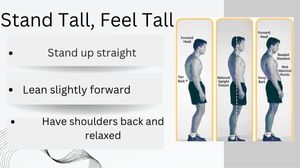How to Mastering Body Language: 7 Proven Tips to Boost Confidence and Charisma
Develop your charisma and self-assurance by mastering body language with these 7 professional tactics. Find doable tactics and highly recommended reading lists to improve your visibility.
The Secrets of Mastering Body Language for Charm and Confidence:
The unspoken language of body language has the power to establish or break relationships in both the personal and professional spheres. Knowing how to read body language may greatly increase your confidence and charm, whether you’re meeting someone for the first time, attending a job interview, or making a presentation.
We’ll look at how to mastering body language with 7 actionable tips suggestions that can change the way people see you. Also, we’ll suggest best books on Amazon to assist you in diving in.
1. The Power of Eye Contact: The Portal to Connection
Making eye contact is one of the most effective body language techniques you can do. It demonstrates your engagement, self-assurance, and reliability. On the other hand, maintaining too little or too much eye contact can give the impression that you are bashful or uninterested.
How to Make Better Eye Contact:
Start small: Start by focusing on maintaining eye contact while having informal discussions with loved ones.
Follow the 50/70 rule: When speaking, make eye contact 50% of the time, and when listening, 70% of the time.
Apply the triangle method: Pay attention in a slight triangle pattern, focusing on one eye, then the other, and lastly the mouth.
Book Suggestion: Michael Ellsberg’s “The Power of Eye Contact: Your Secret for Success in Business, Love, and Life”
2. The Art of a Confident Posture: Stand Tall, Feel Tall
Your confidence is evident in the way you hold yourself. Maintaining a straight spine when standing or sitting helps you feel better on the inside as well as give off an air of confidence.
Advice for a Confident Posture:
Align your body: Maintain a straight neck, spine, and head to maintain proper body alignment.
Balance: Assume a standing position where your weight is equally distributed over both feet.
Practice power poses: To increase your confidence, hold a “power pose” for two minutes prior to significant occasions.
Recommended book: Amy Cuddy’s “Presence: Bringing Your Boldest Self to Your Biggest Challenges”
3. Hand Gestures: The Key to Expressiveness
Using hand gestures to emphasize your points and add interest to your communication is essential. But, utilizing gestures excessively might become annoying, so moderation is essential.
Suggestions for Hand Motions That Work:
Use open palm gestures: Make open-palm movements to demonstrate transparency and honesty.
Avoid fidgeting: Keep your hands still to prevent coming out as uneasy.
Match gestures to speech: For maximum impact, time your motions to the beat of your speech.
Book Suggestion: Allan and Barbara Pease’s “The Definitive Book of Body Language: The Hidden Meaning Behind People’s Gestures and Expressions”
4. Facial Expressions: Conveying Emotion Without Words
Your emotions are clearly shown through your facial expressions. For example, a sincere smile can immediately establish a good rapport.
Suggestions for Gratitude on Your Face:
Practice smiling: a sincere grin uses both your lips and eyes.
Make use of microexpressions: Modest facial gestures might imply sincerity.
Be mindful of your resting face: Make sure the neutral expression you choose is personable.
Recommended Reading: Paul Ekman’s “Emotions Revealed: Recognizing Faces and Feelings to Improve Communication and Emotional Life”
5. Mirroring: The Subtle Art of Building Rapport
Mirroring is a tactic in which you gently imitate the other person’s nonverbal cues. It facilitates rapport-building and increases the other person’s sense of comfort in your presence.
Advice for Mirroring:
Be sensitive: Without being overt, mimic the other person’s posture, gestures, or tone.
Pace yourself: As the talk goes on, progressively mirror more movements from the beginning.
When combined with spoken cues: Utilize comparable terms or expressions to enhance the bond.
recommends reading: “The Like Switch: An Ex-FBI Agent’s Guide to Influencing, Attracting, and Winning People Over” is the book that Jack Schafer.
6. Personal Space: Respecting Boundaries
It’s essential to respect others’ personal space when interacting. A person may become uncomfortable if their personal space is invaded, but keeping appropriate distance demonstrates respect and understanding.
Advice on Keeping Your Own Space:
Recognize the zones: While personal distance (1.5–4 feet) is reserved for close friends, social distance (4–12 feet) is suitable for acquaintances.
Be aware of cues: To determine how comfortable someone is, observe their body language.
Make the appropriate adjustments: If someone backs off, offer them more room.
Book Suggestion: Carol Kinsey Goman’s “The Silent Language of Leaders: How Body Language Can Help – or Hurt – How You Lead”
7. The Impact of Voice and Tone: Speak with Confidence
Although the majority of body language is non-verbal, your voice and tone also have a big impact. Speaking can either support or contradict your body language.
Advice for a Self-Assured Voice:
Manage your pitch: It’s common to interpret a lower tone as more authoritative.
Make good use of pauses: Emphasis can be added by pausing before speaking.
Exercise your modulation: Change up your tone to keep the person listening interested.
Recommended Book:
“Talk Like TED: The 9 Public-Speaking Secrets of the World’s Top Minds” written by Carmine Gallo
Conclusion: Mastering Body Language for Success
Body language mastery is a continuous process that calls for awareness and practice. You may increase your charisma and confidence in every scenario by concentrating on these seven essential areas: eye contact, posture, hand gestures, facial emotions, mirroring, personal space, and voice.
Recall that your body language conveys your feelings about yourself as well as how you want other people to see you. By using these strategies, you’ll not only become more confident in yourself, but your interactions with others will also get better.
Best Books on Amazon to Continue Your Journey:
Ellsberg’s “The Power of Eye Contact”
Amy Cuddy’s “Presence“
“The Definitive Book of Body Language”by Barbara Pease and Allan
Paul Ekman’s “Emotions Revealed”
Jack Schafer’s “The Like Switch”
Carol Kinsey Goman’s book “The Silent Language of Leaders”
Carmine Gallo’s “Talk Like TED”
Last Words: The more you use these strategies, the more organic they will seem, which will boost your charm and confidence in general. Learning body language is an important life skill that will benefit you in every aspect, be it for a huge presentation, a job interview, or just to enhance your daily contacts.










